wikiHow is a “wiki,” similar to Wikipedia, which means that many of our articles are co-written by multiple authors. To create this article, 11 people, some anonymous, worked to edit and improve it over time.
There are 8 references cited in this article, which can be found at the bottom of the page.
This article has been viewed 529,139 times.
Learn more...
Though it may seem like a simple procedure, putting a stamp on an envelope correctly will ensure your letter reaches its destination. The size of your envelope and the weight of your letter will affect how much postage, or how many stamps, you put on the envelope. The standard rules for postage vary by country and may fluctuate over time, so always consult your local post office for current postage rates.
Steps
Determining the Postage for the Envelope
-
1Check the size of your envelope. This should be marked on the packet of envelopes, or on the envelope itself. Size 14 envelopes measure 5" x 11.5" and are considered the standard size.[1] They will be rectangular in shape and will often be sold in packages at your local post office.
- You can also mail a letter in an envelope that is smaller than a size 14, such as a size 10 envelope (4.125" x 9.5"), with a regular stamp.
- If possible, fold your letter so it fits in a standard rectangular envelope, as this may cut down on the price of postage.
- Envelopes larger than size 14 are considered large envelopes, or flats, and will be more expensive to mail.
- Card sized envelopes, made for small greeting cards or wedding invitations, will also likely have additional postage fees. This is because pieces of mail that have an odd shape or are square shaped and made of rigid card can jam mail processing machines and need to be processed separately.
-
2Weigh your letter. You can do this at the post office or on a small office scale. The weight and size of your letter (plus the envelope) will affect the price of postage, or how much you will pay for a stamp. Often, the heavier the letter is, the higher the price of postage will be.Advertisement
-
3Decide if you want to send the letter by First Class, Priority, or Standard Mail. There are three basic levels of mail, according to the US Post Office.[4]
- First Class Mail is often what is used to send letter-size pieces that are rigid and square. To send a letter First-Class, it must weigh no more than 13 ounces. The price for sending First Class Mail is the same, regardless of the distance the letter is traveling. The arrival time for First Class Mail is two to three days for destinations within the U.S. Sending mail First Class is ideal for a single letter as all you need is a standard stamp and access to a post box.[5]
- Priority Mail is ideal if you want your letter to get to the addressee by the following business day. To send a letter by Priority Mail, it must weigh no more than 70 pounds. At the post office, you can add on extra services to your Priority Mail item, such as USPS Tracking and Registered Mail, especially if your letter contains legal or sensitive information that must reach its destination. The price of Priority Mail postage is based on the distance the mail must travel; the further the distance, the more you will pay for postage. This is broken down by nine “zones”. For example, “Zone 1” is local, or the area close to you, and “Zone 9” is the furthest distance away from your location.
- Standard Mail is used for larger quantities of mail, at least 200 pieces or 50 pounds of mail at one time. Envelopes must weight less than 16 ounces. Large envelopes, also called flats, cost more than letters. People use Standard Mail to send flyers, advertising documents, newsletters, catalogs, and bulletins. You can only send domestic mail by Standard Mail and you cannot send one single envelope through Standard Mail.
Putting a Stamp on a Standard Envelope
-
1Buy postage based on the size, weight, and class for the letter. If you need the letter to reach its destination fast, send it by Priority Mail. If you do not need the letter to get there any sooner than three to five business days, send it by First Class Mail. If you aren’t sure what class is right for your letter, ask the attendant at your local Post Office.[6]
- To send a letter that weighs less than 13 ounces in a standard envelope to a domestic address by First Class Mail, it will cost $0.49.
- To send a letter that weighs less than 13 ounces in a standard envelope to a “Zone 1” (local) address by Priority Mail, it will cost $5.75. The price of postage will go up based on the “Zone” or area you are sending the letter to.
-
2Attach the stamp to the envelope. If you are using sticker stamps, peel the paper off the back of the stamp. If you are using lickable stamps, lick the back of the stamp.[7]
- Put the stamp on the top right corner of the envelope. This will allow the postage scanning equipment to read the envelope and process it.[8]
- Make sure the address of the sender and the address of the receiver are not covered or obscured by the stamp.
-
3Place the letter in the mail. Do this by dropping the letter off at your local Post Office, or by putting it in a post box in your area.[9]
- You can also put the letter in your home mailbox for your mail carrier to pick up.
- Any letters that weigh more than 13 ounces must be mailed at your local Post Office.[10]
Putting a Stamp on a Large Envelope
-
1Purchase postage based on the size, weight, and class for the letter. Send the letter by Priority Mail if it weighs more than 13 ounces and the letter needs to get to its destination by the following business day. Send the letter by First Class Mail if it weighs less than 13 ounces and the letter can get to its destination within three to five business days. If you aren’t sure what class is right for your letter, ask the attendant at your local Post Office.[11]
- To send a letter that weighs less than 13 ounces in a large envelope to a domestic address by First Class Mail, it will cost $0.98.
- To send a letter that weighs less than 13 ounces in a large envelope (12-1/2" x 9-½ or smaller) to a “Zone 1” (local) address by Priority Mail, it will cost $5.75. The price of postage will go up based on the “Zone” or area you are sending the letter to.
-
2Place the stamp on the envelope. If you are using lickable stamps, lick the back of the stamp. Sticker stamps can be used by peeling off the back paper on the stamp.
- Put the stamp on the top right corner of the envelope. Make sure it is in line with the return address on the top left corner of the envelope.[12]
- Do not cover or obscure the return address or the receiver address with the stamp.
-
3Mail the letter. Drop the letter in the mailbox at your local Post Office or in a post box in your area.[13]
- You can also leave the addressed letter in your home mailbox. Your mail carrier will then pick it up and put it in the mail for you.
- Letters that weigh more than 13 ounces must be mailed in person at your local Post Office.[14]
Community Q&A
-
QuestionWill the post office deliver a letter if I accidentally placed the stamp on the left upper corner of the envelope?
 Community AnswerYes.
Community AnswerYes. -
QuestionHow do I reattach it?
 Community AnswerIf you are taking it off and putting it back on again just peel it off gently and attach it exactly how you did the first time.
Community AnswerIf you are taking it off and putting it back on again just peel it off gently and attach it exactly how you did the first time. -
QuestionWhy wasn't the stamp on my envelope canceled by the USPS?
 Community AnswerWithout knowing your exact situation, it's hard to say, but it was probably either a mistake on their part, or you misplaced the stamp. I once had a friend send me mail, and her stamp was in the top left rather than the top right, so her stamp was not canceled. I think nowadays canceling stamps is done by a machine, so perhaps the machine wasn't working.
Community AnswerWithout knowing your exact situation, it's hard to say, but it was probably either a mistake on their part, or you misplaced the stamp. I once had a friend send me mail, and her stamp was in the top left rather than the top right, so her stamp was not canceled. I think nowadays canceling stamps is done by a machine, so perhaps the machine wasn't working.
Things You'll Need
- Envelope
- Stamp
- Steady Hand
References
- ↑ https://pe.usps.com/businessmail101?viewname=letters
- ↑ https://www.usps.com/ship/first-class-mail.htm
- ↑ http://www.stamps.com/usps/first-class-mail/
- ↑ https://www.usps.com/ship/mail-shipping-services.htm
- ↑ http://www.stamps.com/usps/first-class-mail/
- ↑ http://pe.usps.com/cpim/ftp/manuals/dmm300/Notice123.pdf
- ↑ https://www.usps.com/ship/letters.htm
- ↑ https://www.canadapost.ca/web/en/kb/details.page?article=addressing_mail_accu&cattype=kb&cat=addressing&subcat=accuracy
- ↑ http://pe.usps.com/text/dmm100/sending-receiving.htm
- ↑ https://www.canadapost.ca/web/en/kb/details.page?article=addressing_mail_accu&cattype=kb&cat=addressing&subcat=accuracy
- ↑ http://pe.usps.com/cpim/ftp/manuals/dmm300/Notice123.pdf
- ↑ http://pe.usps.com/text/dmm100/sending-receiving.htm
- ↑ http://pe.usps.com/text/dmm100/sending-receiving.htm
- ↑ http://pe.usps.com/text/dmm100/sending-receiving.htm
About This Article
Before putting a stamp on an envelope, you’ll need to figure out how much postage to buy. Visit your post office to determine the amount of postage you need based on the size, shape, and weight of the envelope. The postage will also depend on the class of the letter—for instance, Priority Mail costs a little more than First Class. If you’re using sticker stamps, simply peel the stamp off its adhesive backing and place it in the upper right corner of the front of the envelope. If it’s an old-fashioned lickable stamp, lick the back of the stamp to activate the adhesive, or moisten it with a small amount of warm water on your fingertip. Depending on how much postage you need, you might need to put more than one stamp on the envelope. Just make sure all of them are in the upper right corner of the envelope. When you’re done, drop your letter off in the nearest mailbox or hand it in at a post office. To learn how to put stamps on flats or oversized envelopes, like wedding invitations, read on!


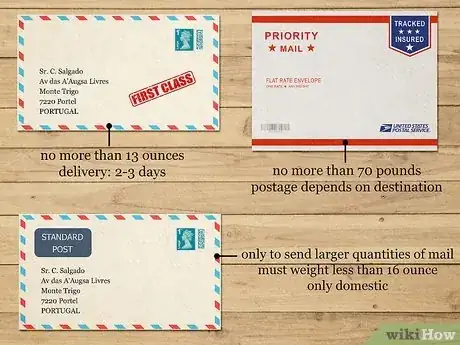
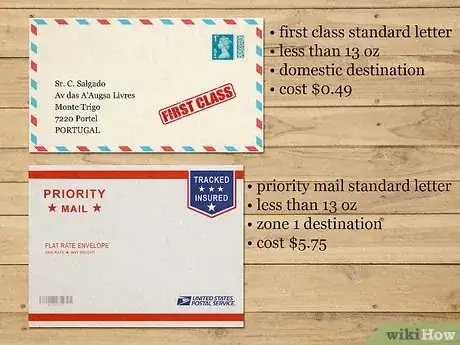


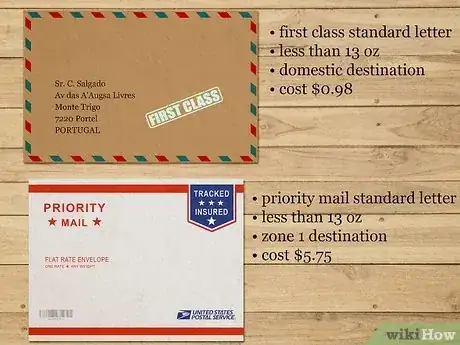
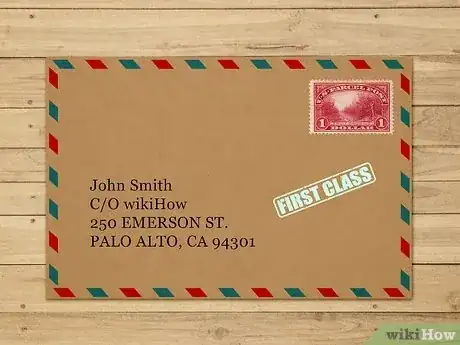

-Step-10.webp)
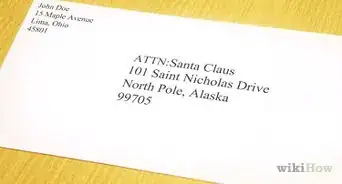

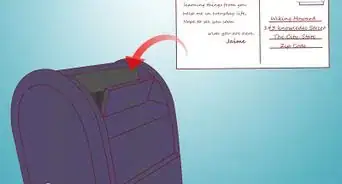






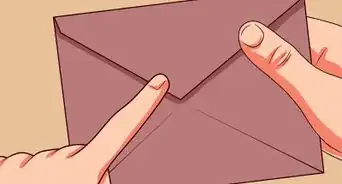









-Step-10.webp)





































